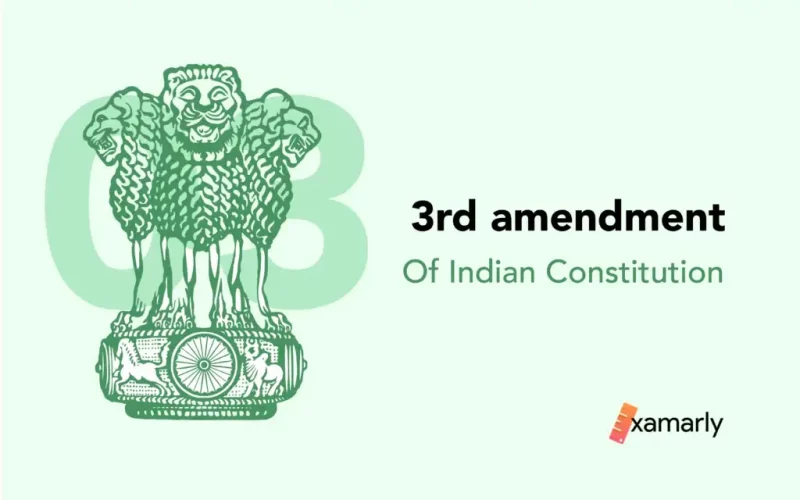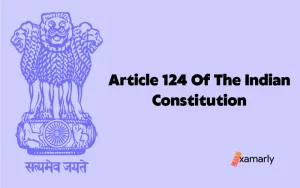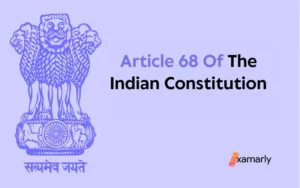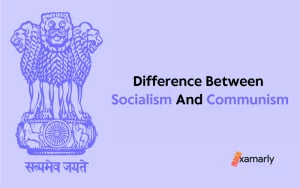Are you looking for a detailed analysis of the 3rd Amendment of the Indian constitution?
Entry 33 of the Concurrent List in the 7th Schedule of the Indian Constitution was reintroduced to include commerce and trade-in, as well as the manufacturing, supply as well as distribution of four categories of vital commodities:
- Raw jute
- Foodstuffs such as oils and edible oil seeds.
- Cotton seeds and raw cotton (either unpinned or ginned).
- Fodder for cattle, such as oilcake and other concentrates.
We will explore the context in which it was introduced and its main provisions. Through this exploration, we will gain a deeper understanding of the significance of the 3rd Amendment and its place in the history of Indian constitutional law for the UPSC exam preparation.
- Objects and Reasons
- 3rd Amendment of Indian Constitution: Facts and Features
- Additional Facts
- Who Introduced the 3rd Amendment of the Indian constitution and Why?
- Ratification
- Conclusion
- Frequently Asked Questions
- What is the 3rd Amendment of the Indian Constitution?
- What was the purpose of the 3rd Amendment to the Indian Constitution?
- Who introduced the 3rd Amendment of the Indian Constitution?
- How was the 3rd Amendment of the Indian Constitution passed?
- Which state legislatures ratified the 3rd Amendment of the Indian Constitution?
- Was the 3rd Amendment of the Indian Constitution controversial?
- How did the 3rd Amendment of the Indian Constitution impact the distribution of powers in the country?
Objects and Reasons
The Concurrent List’s Entry 33 gave Parliament the power to enact laws about industries that had been announced to be subject to Union authority.
Additionally, Article 369 granted Parliament a five-year legislative jurisdiction over a list of specific vital commodities.
After article 369 expired, it was thought unwise to regulate the manufacturing, distribution, and supply of certain of these necessities. In line with this, the bill proposes to expand Concurrent List’s Entry 33.
Read More:
- 17th Amendment Of Indian Constitution
- 64th Amendment of the Indian Constitution
- The 68th Amendment Of Indian Constitution
- 62nd Amendment Of Indian Constitution
3rd Amendment of Indian Constitution: Facts and Features
- On September 6, 1954, the bill of the 3rd amendment of the Indian Constitution was presented in the lower house of the Parliament (i.e. Lok Sabha).
- In the 5th year of the Indian Republic, Parliament enacted it.
- Commonly referred to as Constitution (Third Amendment) Act 1954.
- The entry given below shall be replaced List III’s entry 33 mentioned in the 7th Schedule to the Indian Constitution. Trade and commerce in, as well as the manufacturing, supply, and circulation of any industry’s output, as well as imported commodities of a similar nature, where Union control of the industry has been deemed by Parliament to be desirable in the interest of the public; Cattle fodder, such as oilcake and other concentrates; Raw cotton, whether unpinned or ginned; Foods, such as edible oil seeds and oils; Raw jute.
- Entry 33 of the Concurrent List before the Third Amendment re-enacted entry 33 states the following: 33. Trade and commerce, as well as supply, manufacture, and distribution of merchandise from industries where Union control of those industries is deemed to be in the interests of the public by the law of Parliament.
Additional Facts
- When was the third amendment bill passed?: On 1954, 28th September
- When does the 3rd amendment start?: On February 22nd, 1955
- Who signed it?: Dr. Rajendra Prasad
Who Introduced the 3rd Amendment of the Indian constitution and Why?
The 3rd Amendment of the Constitution of India was introduced in 1954 by T. T. Krishnamachari, who was the Minister of Commerce and Industry at the time.
It sought to make changes to the Seventh Schedule of the Constitution, which lists the distribution of powers between the central government and the state governments.
The original Entry 33 of List III, or the Concurrent List, dealt with trade and commerce in the production, supply, and distribution of goods.
The 3rd Amendment of the Indian constitution sought to replace this entry with a new entry that would give the central government greater control over inter-state trade and commerce. The new entry read:
“33. Trade and commerce in, and the production, supply, and distribution of,- (a) the products of any industry where the control of such industry by the Union is declared by Parliament by law to be expedient in the public interest, and imported goods of the same kind as such products; (b) foodstuffs, including edible oilseeds and oils; (c) cattle fodder, including oilcake and other concentrates; (d) raw cotton, whether ginned or unpinned and cotton seed; (e) raw jute.”
The inclusion of this new entry gave the central government more power over inter-state trade and commerce in certain important commodities.
It also gave Parliament the authority to pass laws regulating the production, supply, and distribution of these goods, and to declare control over certain industries in the public interest.
The 3rd Amendment of the Indian constitution was seen as a significant step in strengthening the role of the central government in the economic development of the country.
However, it was also criticized by some as a step towards centralization and a potential threat to the autonomy of the state governments.
Ratification
The process of amending the Constitution of India is laid out in Article 368 of the Constitution. Any amendment to the Constitution requires a special majority in both houses of Parliament, and in some cases, the ratification of the amendment by a majority of the state legislatures.
The 3rd Amendment of the Indian constitution was introduced by Article 368, and it was ratified by several state legislatures.
The 3rd Amendment was approved by the state legislatures of West Bengal, Punjab, Rajasthan, Saurashtra, Patiala and East Punjab States Union, Madhya Pradesh, Bihar, and Madras.
The ratification of this by these state legislatures was an important step in the amendment’s adoption and implementation.
Each of these state legislatures had to pass a resolution approving the 3rd Amendment of the Indian constitution before it could be ratified.
The process of ratification varies slightly from state to state, but in general, the resolution had to be passed by a majority of the members present and voting in the state legislature.
The approval of this by these state legislatures was significant because it demonstrated that the amendment had broad support across different regions and political affiliations. It also helped to ensure that the changes introduced were uniformly applied across the country.
Conclusion
The original entry 33 of List III was altered, its reach was increased, and its current form was given by the 3rd Amendment of the Indian Constitution which was passed in 1954.
The 3rd Amendment of the Indian Constitution was a significant milestone in the country’s economic development and political evolution.
By granting the central government more power over inter-state trade and commerce, the amendment facilitated the creation of a unified national market and enabled the government to regulate the production, supply, and distribution of certain important commodities.
Its impact on the country’s economy and political system cannot be underestimated, and it remains an important moment in Indian constitutional history.
Related Posts
- 69th Amendment Of The Indian Constitution
- 58th Amendment Of The Indian Constitution
- 57th Amendment of the Indian Constitution
- Important Amendments of the Indian Constitution for UPSC CSE
Frequently Asked Questions
What is the 3rd Amendment of the Indian Constitution?
It was introduced in 1954 and it sought to amend the Seventh Schedule of the Constitution which deals with the distribution of powers between the central government and the state governments.
What was the purpose of the 3rd Amendment to the Indian Constitution?
The main purpose of the 3rd Amendment was to give the central government more power over inter-state trade and commerce in certain important commodities. This was seen as an important step towards centralizing power and promoting economic development.
Who introduced the 3rd Amendment of the Indian Constitution?
The 3rd Amendment was introduced by T. T. Krishnamachari, the then Minister of Commerce and Industry.
How was the 3rd Amendment of the Indian Constitution passed?
The 3rd Amendment was passed in conformity with Article 368 of the Indian Constitution, which lays out the process for amending the Constitution.
Which state legislatures ratified the 3rd Amendment of the Indian Constitution?
The 3rd Amendment was ratified by several state legislatures, including those of West Bengal, Punjab, Rajasthan, Saurashtra, Patiala and East Punjab States Union, Madhya Pradesh, Bihar, and Madras.
Was the 3rd Amendment of the Indian Constitution controversial?
Yes, the 3rd Amendment was controversial at the time because it was seen as a potential threat to the autonomy of state governments.
How did the 3rd Amendment of the Indian Constitution impact the distribution of powers in the country?
The 3rd Amendment gave the central government more power over inter-state trade and commerce, which meant that the distribution of powers between the central government and the state governments was affected.






